Calf muscle tightness: Stretching & Strengthening Exercise
Why is calf muscle tight?
Calf muscle tightness is most commonly seen mainly due to its low usage in day-to-day activity mainly by office workers who have very low ankle movement this may lead to calf muscles losing its elasticity property and muscle become rigid and stiff(tight) if untreated it may lead severe consequences, Regular Ankle movement in a full range of motion helps to maintain Calf muscle fully stretchably.
However there are too many factors that contribute to Calf muscle tightness, in This article here we discuss all possible causes of Calf muscles, Anatomy, and How you can remove this tightness with easy to do Home exercises, and also strengthening exercises of calf muscles.
Anatomy of Calf Muscles :
- The calf muscle is located in the back of your lower leg, behind your shin bone. It actually includes three muscles. Together, the muscles help you walk, run, jump, stand on your toes, and flex your foot (lift your toes up toward your knee).
- The calf is made up of mainly two muscles called the gastrocnemius and the soleus. The gastrocnemius is the larger calf muscle, The gastrocnemius has two parts or “heads,” which together create its diamond shape.
- The soleus muscle is a smaller, flat muscle that lies underneath the gastrocnemius muscle. The gastrocnemius and soleus muscles taper and merge at the base of the calf muscle. Tough connective tissue at the bottom of the calf muscle merges with the Achilles tendon. The Achilles tendon inserts into the heel bone (calcaneus). During walking, running, or jumping, the calf muscle pulls the heel up to allow forward movement.
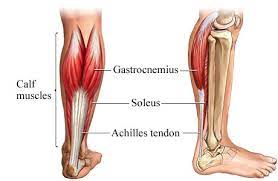
What are the causes of Calf Muscle Tightness?
- Tightness or pain in the calves is often the result of overuse of the calf muscles Activities like running and playing sports can lead to overuse or muscle soreness.
1) Muscle Cramps :
Cramps are the main cause of the calf muscles feeling tight. A cramp is where the calf muscles suddenly and involuntarily contract without relaxing.
some possible reasons why muscle cramps mainly occur:
- not stretching muscles before activity or before performing any exercise
- maybe due t the lack of regular exercise
- weak calf muscles
- a lack of minerals or salts.
- muscle fatigue.
2) Overuse
- overusing the calf muscles can lead to muscle tightness. People who do frequent exercise are at a higher risk of overusing the calf muscles. Continuing to overuse the tight calf can lead to more severe injuries to muscles.
3) Strains
- Calf strains can cause tightness, pain, and swelling in the back of the lower leg.if you are performing Exercising too vigorously can lead to the calf muscles contracting and lengthening, and this action produces calf strain.
- In some severe cases, the same action like repeated stress on the calf muscles can cause a tear of the muscle.
4) Paralysis
Paralysis is the most common cause of Calf muscle tightness, mainly due to loss of Ankle movement, where calf muscles spasticity or Rigidity is also associated with this, Regular Physiotherapy treatment mainly the restoration of movement is helping to regain control of calf muscles.
Other potential causes:
- dehydration
- any side effects of medication
- peripheral vascular disease
- reduced blood flow to the calf
- limited range of motion in the ankle joint
- dietary imbalance or deficiency
- deep vein thrombosis
- Achilles tendinitis
- Plantar fasciitis
- Hemiplegia
- Paraplegia
- sciatica pain
- Varicose veins in the lower limb
- After Fracture Immobilization in lower leg area or Knee joint
Sign and symptoms may include:
Tight calf may you feel hard to touch. The muscles may twitch slightly or feel warm and you will see the muscle spasm. muscle can be painful, particularly when it comes under pressure. There can be cramping in the muscles in some cases.
- swelling and bruising.
- sudden sharp pains.
- difficulty flexing the toes.
- muscle fatigue in the calves.
- sudden pain in the back of your calf or behind your knee
- trouble standing on your tip of the toes
- pain and muscle spasm
- severe pain, especially when resistance is applied to the muscles calf is made up of two muscles called the gastrocnemius and the soleus.
How to Prevent Calf Muscle Tightness?
Stretching regularly may be your best bet for keeping your calf muscles loose and pain-free and healthy. Here are some other way to loosen your tight calf muscles.
- Warm up before doing stretching exercise and any other exercise.
- Check out for your shoes to maintain proper joint and bone alignment to your body.
- Wear compression sleeves, They may help promote better blood flow to your muscles and temporarily relieve pain during motion.
- regular physical therapy this will help you to keep your calf muscles loose and which will prevent calf muscle injury.
- If you participate in sports that aggravate your calves,regular warm up exercise may keep you running strong.
- Work on your overall fitness. Some cramping of the calf muscles which is may be due to muscle atrophy and inactivity of the muscles.
- Stay hydrated, Drink plenty of water throughout the day. Eat a well-balanced diet that includes sources of calcium, potassium, and magnesium.
- massage therapy it is the another option. uses your hands to manipulate the body’s muscles and soft tissues, helping with anything from pain to muscle tension and which will improve your blood circulation.
Benefits of Regular Calf Stretching Exercise:
- Activate the calf muscles: Your calf muscles perform so many functions every day, including standing and walking, so they can easily become tired or stiff.
- The best calf stretches stimulate your muscles and increase blood flow to the area, reducing muscle tightness or calf pain.
- A good stretch will make it easier to use the muscles during physical activities.
- Increase your short-term range of motion: Calf stretching exercises increase your short-term range of motion. If you feel a lot of stiffness or tightness in your calves then calf stretches can be a great option to help prevent injury.
- Increase long-term flexibility: Over time, consistent calf stretches can increase your long-term flexibility.
- Relieve the muscle soreness: While many athletes doing stretching before or after a workout to relieve muscle soreness, However, other researchers suggest that stretching your calves may offer relief in the form of a placebo effect since it activates your muscles and can help you believe that your soreness will subside.
Stretching exercise to relieve your Calf muscle tightness:
Calf stretching Exercise
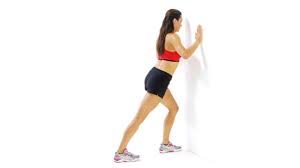
- Stand near a wall or you can use the chair with one foot in front of the other, front knee should be slightly bent.
- Keep your back knee straight, your heel on the ground, and lean toward the wall.
- Feel the stretch all along the calf of your back of your leg.
- Hold this stretch for 10 seconds.
- Switch legs, then alternate stretching of the another limb and repeate it.
Towel Stretch:
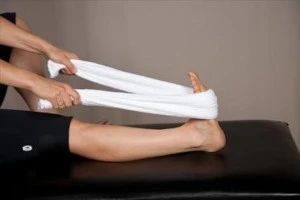
- This stretch requires a hand towel.
- Sit on the floor with both legs straight out in front.
- Loop the hand towel around the ball of one foot. Hold both ends of the towel.
- Keeping the legs straight, pull the towel toward the body, and hold the position for 30 seconds. Then, relax for 30 seconds.
- Repeat the stretch three times, then do the same on the other side.
Gastrocnemius stretching:
Standing Calf Stretch
![[Tags] gastrocnemius strech](https://mobilephysiotherapyclinic.in/wp-content/uploads/2020/10/gastrocnemius-strech.jpeg)
- Ensure both heels are flat on the ground and stretch your calf muscles with use of both hand against the wall. hold this stretch for 20 seconds. Perform it 3 times per day.
Soleus stretch :
![[Tags] Standing soleus stretch](https://mobilephysiotherapyclinic.in/wp-content/uploads/2022/07/footankle3.jpg)
Standing Wall Stretch
- Bend back knee at 45 degrees and keep both heels firmly planted on the ground.
- Hold for 30 seconds, 3 times in the morning and 3 times in the evening.
Foot-on-wall Stretch
- Push your toes against the wall and keep heel firmly locked on the ground to feel the soleus stretch
- ( back of your legs) stretch Hold this stretch for 20-30 seconds.
Dorsi flexion stretch :
- Sit on the floor with legs straight out in front.
- Anchor the elastic band tightly around a stable piece of furniture, such as a heavy chair or table. Wrap the opposite end of the band around the foot. Pull the toes toward the body, then slowly return them to the starting position.
- Repeat the movement 10 times, then change to the opposite side.
Plantar flexion stretch:
- Sit on the floor with the legs straight out in front.
- Wrap one end of the elastic band around one foot, and hold the opposite end.
- Gently point the toes forward, then slowly return to the starting position.
- Repeat this movement 10 times, then change to the leg.
Why Calf Strength is so important?
- By increasing your calf strength you will:
- Become faster in all activity including running, walking and etc.
- Be able to run for longer
- Keep a more consistent place while running. Be able to jump higher.
- you will be able to do all exercises without pain.
Calf-Strengthening Exercises
Straight Knee Calf Raises
- Start with both feet on the ground near a wall or bench to hold on to Lift your heel to go up onto your toes as high as you can.
- Ensure that you’re keeping your weight overall toes evenly and your knees straight. slowly lower back down to the ground.
Bent Knee Calf Raises
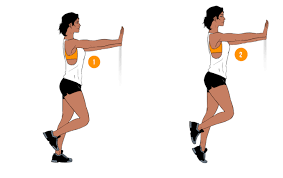
- Start with both feet on the ground near a wall or bench to hold on to. Bend your knees slightly.
- Lift your heel to go up onto your toes as high as you can.
- Ensure that you are keeping your weight overall toes evenly and your knees stay at the same angle; slightly bent.
- and then slowly lower back down to the ground.

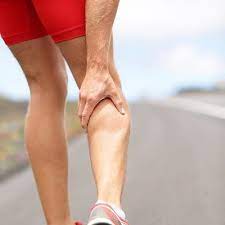
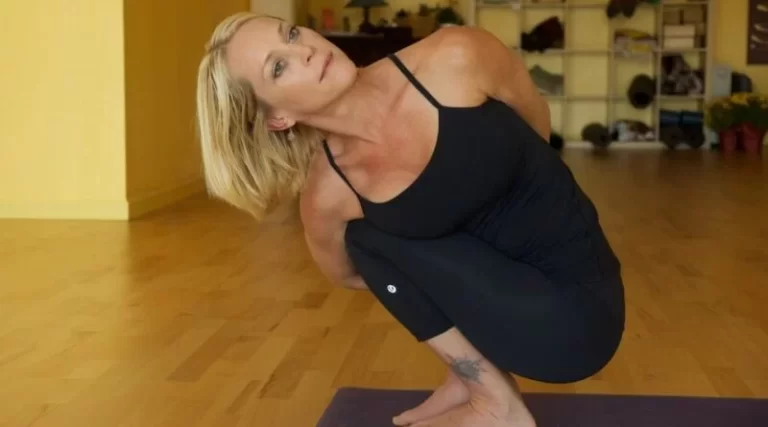

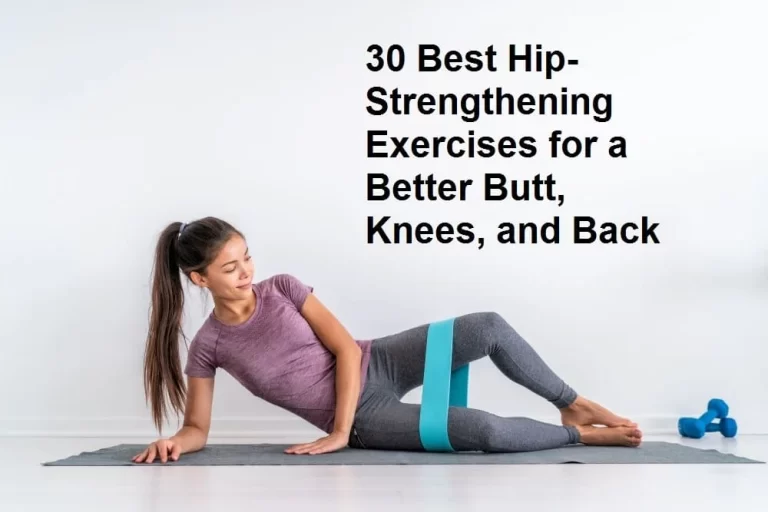
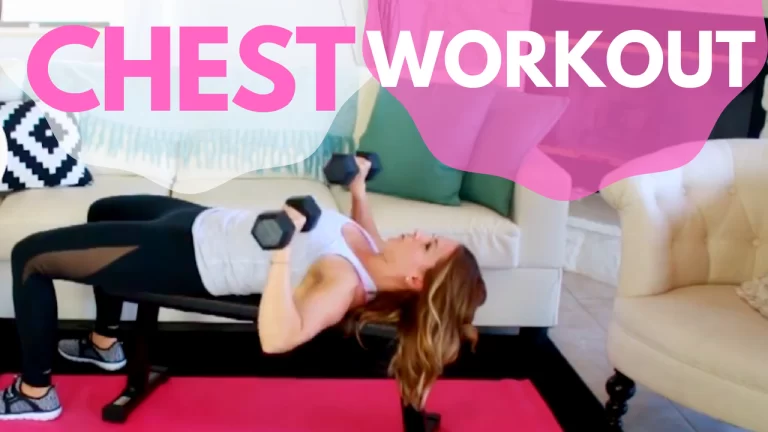
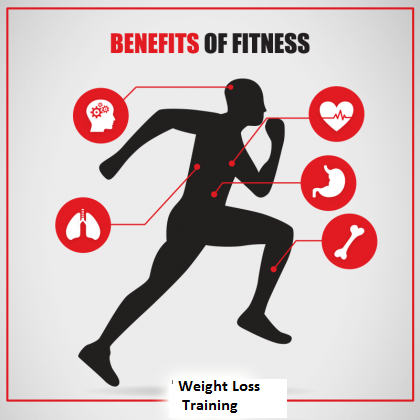
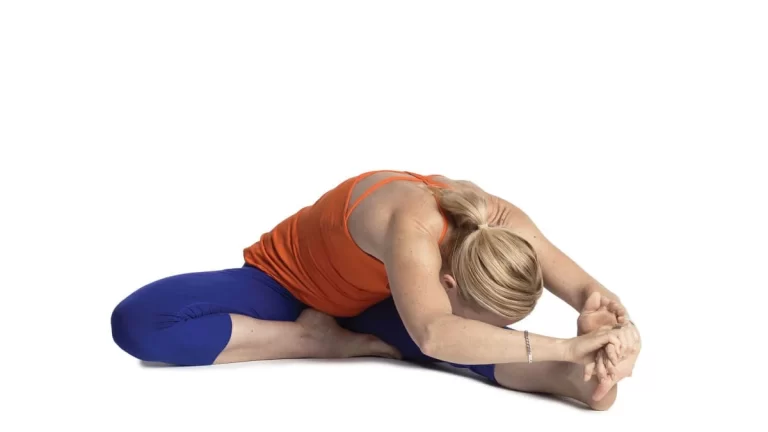
One Comment